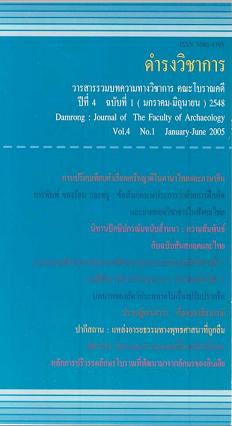Pakistan: The Forgotten Buddhist Cradle
Keywords:
ปากีสถาน, พุทธสถาน, พระพุทธศาสนาAbstract
Pakistan, a well-known Muslim country in South Asia, used to be an important Buddhist cradle during the begining of the Christian era. Gandhara, a western region of Pakistan situated on the western bank of the Sindhu River, is famous for being the first school of art that produced the earliest Buddha statues, and for Taxila - a centre of knowledge since the Buddha’s time. Buddhist sites in the Gandhara region can be divided into 3 areas : Taxila Valley, Swat Valley and Peshwar Valley. There are several interesting sites and monuments in each area, such as Jaulian and Sirkap in Taxila Valley, Butkara in Swat Valley and Takht-e-bhai in Peshwar Valley. In addition to these, the Khyber Pass, an important historical site, is situated in Peshwar Valley.
References
Archaeological Department Government of NWFP, The Three Capitals of Gandhara (pamphlet)
Khan, M.Ashraf; Dr.; Gandhara : Geography, Antiquity. Art and Personalities (Aza Jammu and Kashmir : Islam Ghar, Tech.& Dist. Mir Pur, 2004)
Nadiem, Ihsan H.; Buddhist Gandhara : History, Art and Architecture (Lahore : Sang-E-Meel Publications, 2003)
Pakistan Tourism Development Corporation, Gandhara Civilisation (pamphlet)
Pakistan Tourism Development Corporation, Pakistan : Archaeological Heritage (Rawalpindi : Pap-Board Printers (Pvt.) Limited, 1991)
Rahman, Inayat - Ur -; Mohammad Naeem; Guide to Asoka Rock Edits, Shahbaz. Garhi and Mansehra Pakistan (Peshawar : Printman, 2000)
Salomon, Richard; Indian Epigraphy (New York : Oxford University Press, 1998)
Sammandar, Waqar Ahmad; Takht-I Bhai : World Heritage Site (Mardan : Sammandar Publications, 2003)
Sikander, Mona; "The Glory of the Buried Past : Taxila Archacological Sites and Museum"
Downloads
Issue
Section
License
บทความนี้เป็นผลงานของข้าพเจ้าแต่เพียงผู้เดียว และ/หรือเป็นผลงานของข้าพเจ้าและผู้ร่วมงาน ตามชื่อที่ระบุในบทความจริง และเป็นผลงานที่มิได้ถูกนำเสนอหรือตีพิมพ์ที่ใดมาก่อน





